What Would a Joe Biden Fracking Ban Look Like? Part Five: A Fracking Ban Would “Make America Dependent Upon Russia and OPEC, Again!”
During the Democrat debate between Vermont Senator Bernie Sanders and former Vice-President Joe Biden on Sunday, March 15, 2020, Vice-President Biden stated that he would allow “no new fracking.” However, this would be an incredibly bad idea because it would crush America’s surging oil and gas industry and make the United States dependent upon foreign sources of natural gas and oil, like Russia and Saudi Arabia, again.
This article is the fifth installment in this series.
Flexing America’s Energy Muscles
It wasn’t long ago that Americans were convinced that our country was running out of oil and natural gas, and that the ensuing shortages of these important fuels would lead to chaos. However, the Peak Oil crowd was proved wrong, as the innovative combination of horizontal drilling and hydraulic fracturing, which are often collectively called “fracking,” turned this idea on its head.
Instead of the United States running out of oil and natural gas, we’ve never produced more of these commodities than we are today. We’re also producing more oil than Saudi Arabia, and more natural gas than Russia, as you can see in the graph from the U.S. Energy Information Administration (EIA), below.
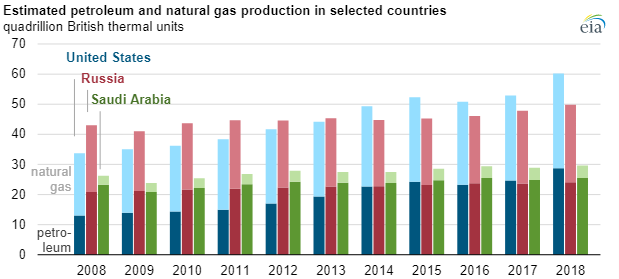
This is important, because it means we are not as beholden to these countries for our energy needs, and it strengthens America’s geopolitical power around the globe.
Drill, Baby, Drill-Booming Oil Production
Oil production in 2008 was just 5 million barrels per day, the lowest it had been since 1947. It’s not surprising that Peak Oil is what all the “smart people” were talking about during this time. However, as politicians like President George W. Bush were decrying America’s “addiction to oil,” wildcatters in North Dakota and Texas were working to unlock millions of barrels of oil that had been previously inaccessible.
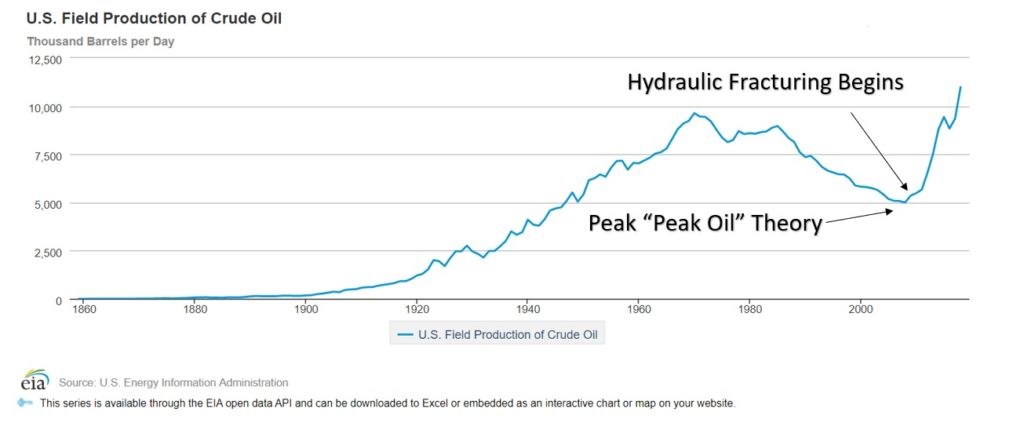
By 2010, production began to increase in these states, by 2015, fracking had doubled America’s oil production, with Texas, North Dakota, and New Mexico seeing the largest increases in crude oil production. As of 2018, fracking was responsible for 60 percent of all U.S. oil production.

The surge in production has caused U.S. oil imports to fall substantially, and there is more good news. Not only have overall imports fallen, but imports from countries like Saudi Arabia and Venezuela have fallen the most, while imports from Canada, our friendly neighbors to the north, have increased. This means North America is less dependent on other sources of oil today than we have been in a long time.
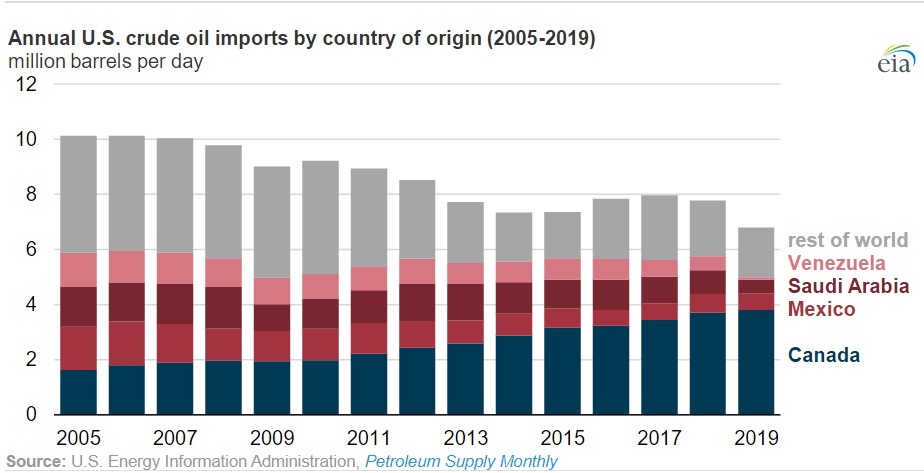
On a side note, we would see the amount of imports from Canada increase even more if former President Obama hadn’t delayed the construction of the Keystone XL pipeline, and if Governor Walz had not delayed the replacement of the Line 3 oil pipeline. Because much of the crude oil coming from Canada is heavier crude, it is more likely to displace Venezuelan and Saudi Arabian imports.
According to EIA data, the United States imported about about 500,000 barrels of oil per day from Saudi Arabia in 2019. The current Line 3 is pumping 390,000 barrels per day, and it will pump 760,000 barrels per day after the new and improved pipeline is installed. This means that the additional capacity of Line 3 will be the equivalent of 74 percent of all the oil we import from Saudi Arabia, and in total, Line 3 will be able to import 52 percent more oil than we currently buy from the entire country of Saudi Arabia. This is just one more reason why Governor Walz should stop playing political games and get Line 3 built.

Expanded American oil production has had a profound impact on oil markets throughout the world, and America’s new found supply of natural gas has been equally transformative.
Drill, Baby, Drill- Booming Natural Gas Production
I’ve already discussed the enormous uptick in natural gas production as a result of fracking, but it bears repeating: fracking is now responsible for 70 percent of all American natural gas production. This has provided Minnesota families with enormous savings on home heating, and completely reversed the supply forecasts for natural gas production in the United States.
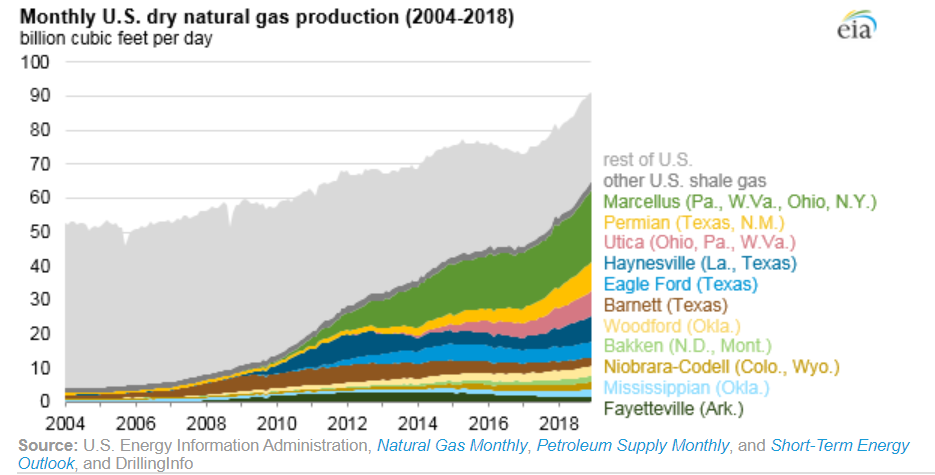
In fact, in 2003, Allan Greenspan, who was then the head of the Federal Reserve, said the United States must build facilities to import natural gas from other countries to avoid volatile prices that hurt American companies. Today, many of the companies that were building import facilities for natural gas have retrofitted them to be export facilities because the United States has become completely independent for our natural gas needs.
In fact, the International Energy Association predicts the United States will become the largest exporter of liquefied natural gas (LNG) in the world in the new few years. This development seriously hinders the power of Russia, which has traditionally used its vast natural gas supplies as leverage to get its way in Europe, because now countries have the option of buying American gas instead of importing it from Vladimir Putin.
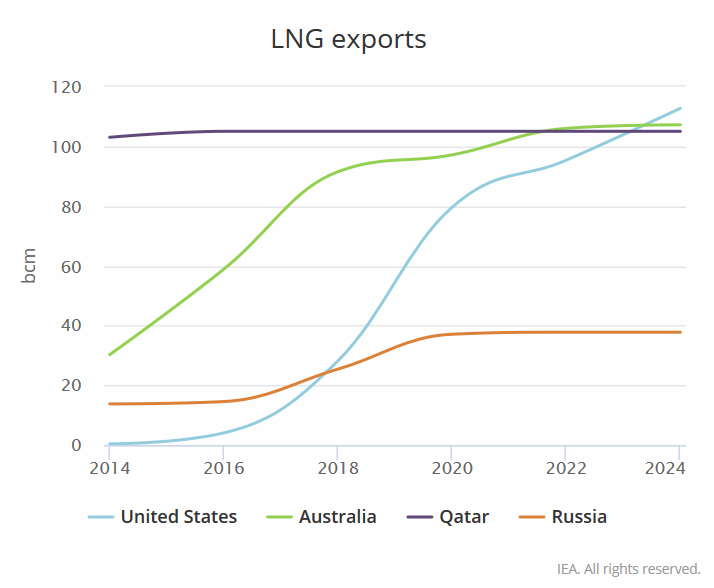
In this way, American energy production is a critical check on the power of Russia and OPEC to restrict supply and increase prices. American energy has benefited the entire world by lowering energy prices and diversifying the world’s energy supply. Hydraulic fracturing, not wind or solar, is the true energy revolution of the early 21st century. It has enriched the lives of people around the globe by making it less difficult to afford to travel to work and heat their homes.
Additionally, fracking has put billions of dollars into the coffers of state governments, whereas wind and solar are totally dependent upon government mandates and subsidies. Banning fracking would be an enormous step backward, resulting in skyrocketing energy costs and abandoning America’s leadership role in the world’s energy markets.